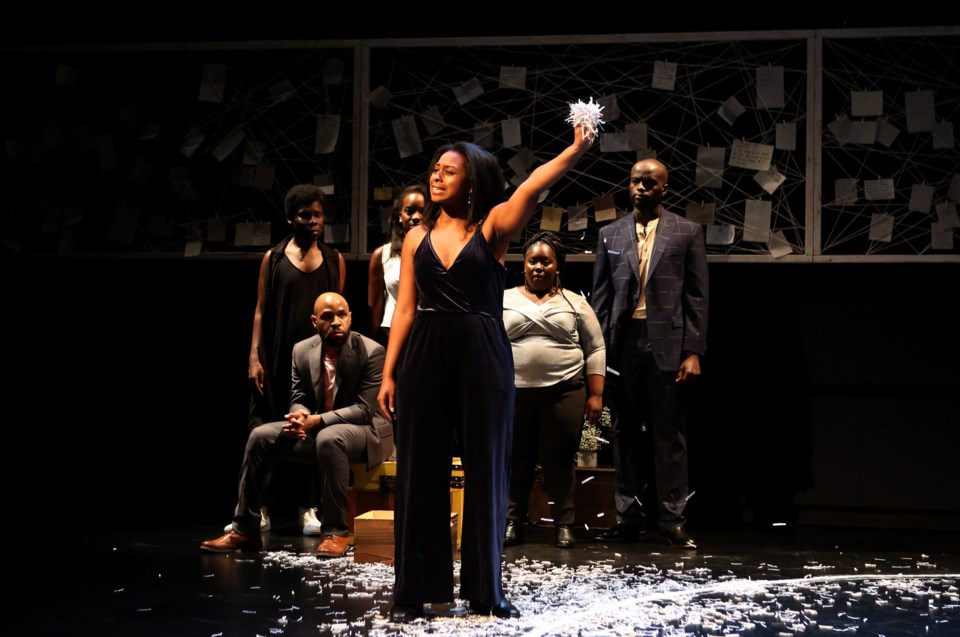Sometimes you just want to yell. Why? Because it feels good to get the anger and frustration out.
Trayvon Martin, Sandra Bland, Eric Garner and George Floyd are some familiar names among the many victims of racialized violence, often at the hands of law enforcement.
Will it ever end?
An original theatrical experience at the Brooklyn Academy of Music offers a moment of healing from the pain, a chance for reflection and discussion while honoring the memory of the numerous Black lives lost.
BAM and Playwrights Horizons, in association with The Movement Theatre Company, present Aleshea Harris' piece What to Send Up When It Goes Down.
It plays at BAM Fisher through July 11 and will also have a staging at Playwrights Horizons in the fall.
Harris is part of the vanguard of talented, young Black playwrights, a circle that includes Jackie Sibblies Drury and Jeremy O. Harris.
What to Send Up is part memorial, part ritual and part performance. It's a cathartic, no-holds-barred exploration of racism, as well as an expression of Black joy.
This theatrical work, originally scheduled to take place at Brooklyn Botanic Gardens because of COVID-19 restrictions, was created specifically for a Black audience but welcomes non-Blacks.
Upon entering Fisher's intimate theater space, actress Kalyne Coleman asks the audience to remain standing and to form a circle. In a commanding voice, Coleman says she wants to clarify a few things.
First, she points out that studies show Black people in America are more than twice as likely as whites to be killed by police, who typically go unpunished.
"This concerns us," she says, adding that they are also concerned about the emotional and physiological toll it takes on Black people.
"Let me be clear: this ritual is first and foremost for Black people. Again. We are glad non-Black people are here. We welcome you, but this piece was created and is expressed with Black folks in mind," she continues.
The actors then lead the audience in therapeutic exercises, including singing, breathing and writing a message, before asking them to sit.
A series of vignettes comes next. Each one is later retold with variations in tone and intensity.
Part of the message running through each sketch is that anti-Blackness is often subtle and unconscious. It calls for honest introspection for whites.
In one vignette, male actor Ugo Chukwu plays Miss, a Southern belle "not unlike Paula Deen," wearing pearls and lace gloves.
Miss (unconvincingly) insists that she is kind and fair to her Black servants: a driver and maid (named Made) whom she demeans and intimidates.
The servants deal with their racist employer and the social system that reinforces Black subservience in different ways.
The driver (Beau Thom), fearful of angering Miss, ingratiates himself. He manages the circumstances by becoming a Sambo figure, the caricature of a Black man who survives racism through loyalty to the oppressor and contentment with his place in society.
Made (Rachel Christopher), on the other hand, suppresses her rage against the system of oppression to the point where she's like a volcano ready to explode.
In another sketch, a Black woman (Denise Manning) tells her friend about an experience at work.
"I was trying to explain things calmly," she recalls her conversation with a white co-worker who told her that he "doesn't see color."
That office scenario is familiar to many Black people.
How do you convince a white person that he's not as color blind as he believes he is? His prejudice, perhaps unconsciously, comes out when he always confuses one Black co-worker with the only other Black person in the office.
It's also evident when he can't understand why it's insulting to tell his highly-educated Black co-worker that she's articulate.
At the end of the performances, the actors politely ask the non-Black people to leave the room so that Blacks in the audience could linger a little longer in a safe space where they could share their mutual grief.
Black people sometimes want to have a conversation among themselves, away from their non-Black allies, to express the pain and anger they feel. Allies in the struggle for racial justice could empathize, but can never completely get it. They would have to be Black to fully understand the Black experience.
Whether you're searching for catharsis or a refreshing and original theater experience, What to Send Up fits the bill.




